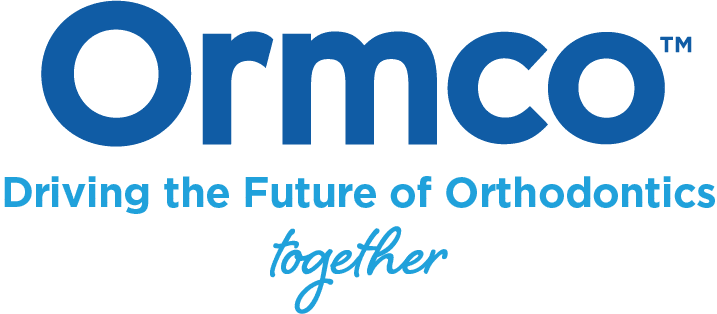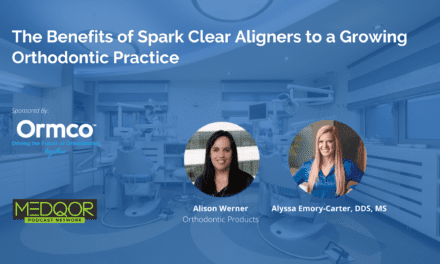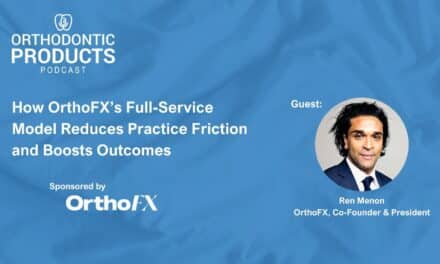Summary:
In this episode, sponsored by Ormco, Colby Gage, DMD, discusses how digital workflows and data-driven strategies are transforming orthodontic practices, emphasizing efficiency, patient outcomes, and the integration of Ormco’s product innovations.
Key Takeaways:
- Digital workflows improve treatment planning, reduce chair time, and enhance practice efficiency.
- Tracking key business metrics like conversion rates and value per visit helps optimize profitability.
- Selecting comprehensive product solutions from a single provider simplifies management and improves workflow integration.
In this episode of the Orthodontic Products podcast, sponsored by Ormco, host Alison Werner speaks with Colby Gage, DMD, a board-certified orthodontist and the founder of LevelUp Orthodontics in Parker, Colo. Gage, who also serves as an orthodontic faculty member at Western University of Health Sciences, discusses the changes in orthodontics. As an Ormco insider and paid consultant, he talks about the company’s approach to digital workflows and practice management and how its product portfolio is designed to meet the changing needs of orthodontists.
Background and Practice Philosophy
Gage describes his career in orthodontics, from his early experience in Canada to launching his practice in 2020. His goal for LevelUp Orthodontics was to improve efficiency, establish a strong brand identity, and focus on patient outcomes. He explains how working with Ormco helped him integrate digital solutions to enhance practice operations and reduce treatment times. One trend he noted was that more adult patients were opting for braces over aligners, which influenced his treatment approach and patient conversion strategies.
Industry Trends and Metrics
Gage discusses key industry trends, including a shift away from traditional referrals, increasing operational costs, and the importance of business strategies in orthodontic practices. He emphasizes the need to track metrics such as treatment time, value per visit, and conversion rates. By using data analytics from Gaidge, he has adjusted his practice approach, achieving a higher conversion rate and increasing revenue per visit beyond industry averages.
The Role of Digital Workflows
A significant part of the conversation focuses on the role of digital workflows in orthodontics. Gage explains how Ormco’s digital bonding system has improved his practice by allowing for pre-planned cases, reducing chair time, and making treatment more efficient. He describes how using systems like the Damon Ultima bracket and Spark aligners has streamlined operations and improved treatment outcomes. He also highlights the importance of training staff when implementing new products to ensure smooth integration.
Episode Lessons
-
Utilize Digital Workflows: Implementing digital bonding and structured treatment planning can help reduce treatment times and improve patient experience.
-
Monitor Business Metrics: Tracking conversion rates, value per visit, and patient treatment timelines can support practice profitability.
-
Select Integrated Solutions: Working with companies that offer a full suite of products and support services can simplify practice management and improve efficiency.
Looking Ahead
Gage shares his perspective on the future of orthodontics, emphasizing the value of collaboration among practitioners. He suggests that adopting new technologies and sharing best practices can help improve patient care and operational efficiency. He believes that technology and data-driven strategies will continue to shape the industry in the coming years. OP
Podcast Transcript
Alison Werner (00:08)
Hello and welcome to the Orthodontic Products podcast. I’m your host, Alison Werner. In this episode sponsored by Ormco, we’re going to talk about how the company is responding to orthodontist’s evolving needs and how it has created a comprehensive product portfolio that aims to empower orthodontic providers to utilize digital workflows and better address patient needs rather than simply selling what they have always sold. And to do that, we’re joined by Dr. Colby Gage. Dr. Gage is a board certified orthodontist with a private practice Level Up ortho in Parker, Colorado.
He serves on the orthodontic faculty at Western University of Health Sciences, his dental school alma mater, and lectures on digital orthodontic systems and practice management topics, the two topics that will be at the center of our conversation today. He is also an ORMCO insider and a paid consultant for ORMCO.
Dr. Gage, thank you for joining me.
Colby Gage (00:53)
Yeah, thank you, Alison. This is quite a pleasure and I love talking about what makes our practice different in various forums, whether it be in dental schools or to orthodontic residents. But this has been a really great change that we’ve seen in the industry recently and I’m excited to discuss it more.
Alison Werner (01:07)
Great. Okay. So to get started tell me about your practice. But first how long have you been in orthodontics and how did you get where you are today?
Colby Gage (01:16)
Yeah, it’s great. Well, I graduated 10 years ago from AT Still University. I initially took a job in Canada and had a practice up there and then wanted to come back to the United States and be closer to family. So I did a startup in 2020, which is the best year to do a startup, right? No problems at all in 2020.
Alison Werner (01:30)
Got ya.
Colby Gage (01:33)
A
little slow start with various things, but it’s been absolutely awesome. I caught wind of a lot of new products and new things that Ormco was doing. As I made that move and transition, I was looking to partner with a company. I really wanted a company that was moving in new directions, that had new innovation, and it was investing into their products. I didn’t want to just use the same stuff that I was doing, and I wanted to create a practice from the ground up that had a strong brand presence that was specifically geared towards results. I think I reached that part in my career
where I really cared more about the end results than I necessarily cared about just getting more patients in the chair. And I wanted to make sure that when I did pick a company that it had a full breadth of products that I wanted to use, and that those products were cutting edge, and that they had systems around them so that it would make it easier to train my team members and have just an overall higher efficiency. So it really made a lot of sense at the time.
to partner with Ormco as they were making a shift in their products and helping to address the needs that I had. It just really helped a lot. And I think the next thing was that I wanted a company too that took a lot of the needs of orthodontists and residents into consideration. that was how I first got started with Ormco, was lecturing to residents. And they saw that need and that shift and they were willing to do it. And that’s kind of the rest has been history now, lecturing for them for the last couple of years.
Alison Werner (02:46)
Okay. Okay.
Okay, so as you mentioned there, you do lecture frequently and often on digital workflows and practice management. So you’ve seen and talked about how the field has evolved over the years. What are the key trends shaping the future of orthodontics as you see it?
Colby Gage (03:00)
Mm-hmm. Yes.
Yeah, you know, when I opened up Level Up Orthodontics in 2020, I had come from a very heavy aligner practice, and I kind of thought that aligners were going to be the mainstay of my practice, that the digital aspect from plastic would be the main modality that my patients would request and that I would recommend for patients. And I noticed that more and more adults were choosing braces over aligners. And I also noticed that the amount of money that patients were willing to put down also was lower. So you kind of have to be a little bit smart about how you’re looking at patients’ finances
and making sure that if you’re gonna get maybe fewer consults or see maybe less patients, how can you make sure that the conversion rate is there, you know, so that you’re actually converting the patients that are coming in and that you’re creating an environment that attracts the right kind of people, right? So that we wanna make sure that everything from our branding, our messaging to the products that we use is reaching those clients that we know are gonna build our practice from the inside out because we can’t rely as much on outside referrals. And I think that’s been the biggest trend
we’ve seen is that we can’t just assume that the dentist that we’ve known for five, 10, 20 years is going to be there. We’re seeing consolidation from DSOs that are taking some of those referrals away. We’re seeing more and more pediatric dentists that are bringing orthodontists in. And then we’re also seeing trends where, you know, now that the practices are getting bigger, those revenue markers are getting higher, but we’re also seeing the expenses creep up. And so our staff expenses are higher than they used to be. We have record inflation. And so all of these trends kind of piece together a practice
where we have to all level up in how we practice to make sure that we’re not falling behind in some of these metrics.
Alison Werner (04:42)
Yeah.
Yeah. So talk to me about what metrics you are tracking as you go along.
Colby Gage (04:52)
Hmm.
Yeah, so there’s lots of different ways you can look at a practice health. And I use Gaidge Ortho and they’re kind of a analytic software that pulls out data from practices. And I look at their data and what they’re putting out to really help me understand what’s going to drive my practice. And they’ve identified multiple things, both market trends, as well as trends within the field. They can pull out things like average treatment time. You know, the average treatment time kind of surprises people when they hear the average treatment time in the U.S. is 27 months for your typical braces patient.
Alison Werner (05:23)
Yeah.
Colby Gage (05:24)
quote, 18 to 24 months, right, to our patients. So clearly right off the bat, there’s a little bit of a disconnect between what we think we’re doing and what’s actually happening. And so when we look at those key data factors, I think one of the main things is value per visit, is how much revenue do we create per visit in the chair? And keeping that number as high as possible is what’s gonna keep our practice healthy. The other one is making sure that our starts equal our debonds or in another way, that our patients aren’t going over treatment time.
Alison Werner (05:25)
Mm. Mm-hmm.
Okay.
Colby Gage (05:53)
you
Alison Werner (05:53)
Mm.
Colby Gage (05:54)
Because if they’re going so far over treatment time, those are the people that we need to focus on to get them out of treatment so that we can become profitable again. And then finally, just making sure that every day that we’re in the clinic, we’re starting as many people as possible. So our starts per day worked. That metric typically needs to be higher than three per day in order to get the maximum benefit of our practice. And many days, we’ll see offices that will get five, six, or seven starts in a day. And that comes down to TC conversions and making sure you’re attracting the right people.
So those are the metrics that we’ve been really focusing on this last year. Our conversion rate now is over 90%, which is really incredible. We’ve had a lot of success in helping identify the right people. Our actual value per visit in many cases exceeds $1,000 for aligners and is around the $700 mark for braces. So you’re looking at that compared to the averages that Gaidge is showing around $300 using the products that we’ve been able to bring over with Ormco. We’ve been able to really, really do much better than that to the point where
Alison Werner (06:32)
Okay.
okay.
Mm-hmm.
Colby Gage (06:54)
where I’m not so worried about the incremental cost of a bracket or the materials I’m using because my profit per visit or value per visit is so high.
Alison Werner (07:02)
Yeah. Okay. So talk to me
a little bit more specifically about how that data you talk started there. Talk to me a little bit more about how that data influences your product choices.
Colby Gage (07:08)
Mm-hmm.
Yeah, so when we looked at the products, I learned a lot about efficiency learning from Dwight Damon and going to some of the Ormco meetings. Ormco threw some great educational events with lots of different speakers with different backgrounds. And I went to a lecture early on when the Damon Ultima bracket was first launched, right around when I opened my practice. And I could see that there was somewhat of a recipe to follow to get these great results. And when they showed how each wire does something a little bit different, think that Damon Ultima system is quite unique in that by typically the third wire we’ve
completely controlled all of our rotations. We’ve created a beautiful arch form and we’re getting a lot of the early expression that we weren’t getting in previous systems with a of control as well. getting to the point where picking the products that I knew would have a predictable result helped me to reverse engineer and say, okay, if I can get my treatment times down and make sure each visit is valuable, each visit actually moves forward the treatment, then I know that I’m not going to have a problem with patients going overtime.
I’m not gonna have a problem with staff not understanding what’s next, right? If they can follow that kind of cookbook or that recipe, I know that the results will follow. And so when I learned about the Daemon Ultima system, that was initially what drew me to it or had that initial attraction because I didn’t wanna be just doing the same things I was always doing. I wanted to make sure that I was getting these patients treated faster and with better results.
Alison Werner (08:37)
Yeah. Well, you mentioned staff there and I want to kind of take the product question a step forward, you because you make a decision whether to purchase a product or try it out. But then you have to actually make the decision whether to integrate it. And that’s the decision that affects the workflow for you and for your staff. So how do you know when it’s time to fully integrate a product into your practice?
Colby Gage (08:39)
Yeah.
Yeah,
yeah, you know, a lot of times, you know, you might hear just around with orthodontists, say, I’m going to try a bracket out or I’m going to try a couple cases. And for me, I did the due diligence of researching the different brackets that were out there and we jumped right in.
We went 100 % in with Damon Ultima when it came out. We were the first office in Colorado to bond it and subsequently also trialed Spark as well and used that exclusively in our practice now. I think when you’re looking at a practice and what matters to them, I think you have to look at what your talents are, what things draw your patients into the practice. If you have a lot of patients that really value good quality service, quality products, want to do things one way, the right way, they don’t want to re-visit
things in the future, they’re gonna value the brand that the Daemon Ultima system or that Ormco has created. They’re going to value that higher touch and feel and finish. And when I’m thinking about my own team, I wanna make it as easy on them as possible. Typically, we put our team first, right? Even ahead of our patients, because we know if we take care of our team, they will take care of our patients, right? And so if I have a product that’s easy to use that has…
Alison Werner (10:01)
Mm-hmm.
Colby Gage (10:10)
you know, good wires, good bracket doors are easy to place and position and it has a sequence or a system attached to it. I know that it’s going to be much easier to train a team member on that versus essentially something that I kind of put together in the garage that’s maybe, you know, older than me that doesn’t really have a cookbook or actual recipe to it. So all of those things, you know, together, I knew I wanted the results that came with the bracket and I saw the results in those lectures and I was inspired and knew that that was
Alison Werner (10:27)
Mm-hmm. Yeah.
Colby Gage (10:40)
that was the direction I needed to take. I think when I just take a step forward, that initial step can be a little bit hard. And sometimes feeling comfortable to do any integration you need, it’s a team effort, right? So when I took the team to some of these meetings and really said, hey, these are the results that we want for our patients, right? And we all kind of agreed, yeah, this is what we want. Then from there, the rest of it was easy because we knew that the steps that we had to take would follow one after another and we would get to that destination, which has been really exciting.
Alison Werner (10:51)
Yeah.
Mm-hmm.
Okay, so talk to me a little bit more about your digital workflow. How has that workflow kind of impacted your practice and the products that you’re integrating there?
Colby Gage (11:20)
Yeah, so the digital workflow, know, we typically think about digital workflow, we think about aligners. And one of the things from my previous practice in Canada, we did all indirect bonding and we did it in house without the digital aid to help simulate where the teeth would go. When I heard about Ormco digital bonding that was going to be coming out about a year or so after I opened my practice, I immediately said, okay, this is the product I’ve been waiting for. This is what I want to be able to treatment plan my cases just like I do with an aligner case. So when I take a,
Alison Werner (11:25)
Yeah.
Colby Gage (11:50)
a look at my practice and the day-to-day of what I’m doing, I want to make sure that my activities in the practice are revenue generating and that I’m not spending a lot of time, you know, going back and looking at things or, you know, spending time treatment planning but it doesn’t get recorded correctly or, you know, doing extra work that doesn’t actually make the patient’s experience better. So with the Ormco digital bonding, what I really enjoyed is that I can visualize the patient’s smile before they’ve even started treatment and I can plan things like IPR or plan the re-
Alison Werner (11:58)
Mm-hmm.
Okay.
Colby Gage (12:20)
contouring of the smile to create something truly unique without being distracted at the chair when I have, you know, five different things going on at once, right? Or I’m worried about the patient’s hygiene or there’s a broken bracket. It kind of frees me up from a lot of those distractions and gives me some time, which I typically spend about a half an hour before lunch doing this. And I have an assistant with me who’s helping cue up the cases. And then we’re looking at the notes at the same time on two different screens. So that if the patient said something particular in the consult, that I didn’t miss it in the planning stage.
And then from there, we just execute the plan. So it actually speeds up the chair time and the whole process for the patient, but it just gives me about 10 minutes of focused time to make sure we, know, dot our I’s and cross our T’s before they’re even there. So it’s been a huge game changer in my time and keeping me focused and more of an architect rather than a construction worker in the practice.
Alison Werner (12:52)
Okay.
That’s a good analogy.
Okay, so you’ve talked a lot there about Damon Ultima and ODB, which on the bracket side, talk to me a little bit more about how you’re using aligners in your practice. You did mention that you’re using Spark. Talk to me about that.
Colby Gage (13:22)
Yeah.
Yeah, when I first came to the practice here again in Parker, Colorado, I had to use another aligner company and I decided to trial both at the same time in my new location to see kind of how they would match up. The first thing I noticed was Spark is that the patients really liked the clearer plastic and they felt that the fit and finish of the trays was better than what they had previously experienced. So just from that initial trial of a hundred patients that I did with both companies, the overwhelming majority wanted to use Spark because of just those simple manufacturing changes.
What I noticed clinically was that the cases tracked better, that I didn’t have as many refinements, and I wasn’t struggling as much with as many attachments or difficult movements that I had to do previously. So that initial realization took a little bit longer to see how the actual cases would treat out, but from the encouraging feedback that I got from patients in the aligners, and then over the first maybe two years using Spark in my practice, I saw tremendous results that I wasn’t seeing before. And going back to that Gaidge
Alison Werner (14:15)
Mm-hmm.
Colby Gage (14:24)
data about value per visit, we’re typically able now to finish our aligner cases in anywhere from five to seven visits in person, which puts our value per visit closer to $1,000 or sometimes higher with our current fees. So at that point, it’s a win for everybody because I know my patients love coming into the office. We have arcade games and we try to make it fun, but ultimately they’re happier if they don’t have to come in, right? And so by not coming to the office, we’re making more money, they’re happier.
Alison Werner (14:31)
Okay.
Mm, okay.
Yeah.
Right.
Colby Gage (14:53)
So it’s a win for everybody.
Alison Werner (14:55)
Okay, so as we close out this discussion, what are kind of the key takeaways you want doctors to have from this conversation when they’re looking at integrating new products into their practices?
Colby Gage (15:06)
Well, doctors have a lot of different hats that they have to wear. You know, we have a clinician hat, we have a CEO hat, you know, we have a technician hat, even sometimes we have to do lab work. mean, there’s so many things that orthodontists choose to do or that do as part of a modern practice. And I think we don’t have to think of them being mutually exclusive. It’s not that, well, this doctor is a really good business person or this doctor is a really good clinician. I think both of those can exist at the same time. And so when we’re looking at products to use, I would look at products that
Alison Werner (15:15)
Yeah.
Colby Gage (15:36)
that have a good reputation, that have staff and salespeople that can support and help train your team. And then also a company that is investing in all the various aspects of your office. We don’t want a company that just has one product to sell. I’m thrilled to use Ormco because now I have one rep for both my aligners, my digital braces, and just my regular bracket orders. So I’m not going to six different companies to piece that together.
You
know, on top of that with, you know, understanding, you know, the business side versus the clinical side, I would say if you’re, if you’re looking at the different products to use, try to find something that meets all of your needs. Looking at that Gaidge data, for example, if I can be really efficient and decrease the number of visits and I can finish patients faster, then I know I’m going to be more profitable and more able to do all the other things I want in my practice, whether it means, you know, taking an extra half day off a week because I don’t need to be in the clinic as much in certain areas.
in areas in the United States, can have certain adjustments done by the assistants and you don’t need the doctor there or you need less oversight. And there’s so many opportunities for that with these products, particularly the digital setups and the digital bonding that I feel confident that if a doctor’s willing to try to redesign their practice from the inside out, if they partner with Oramco with the products that they have now, they’ll have the easiest time that they’ve ever had jumping in and taking that step to make their practice more efficient than
ever
before.
Alison Werner (17:07)
Okay well one more question before I let you
go. What excites you about the future of orthodontics?
Colby Gage (17:14)
That’s a good question. mean, honestly, I think all of it’s exciting. I think my…
The best part for me is knowing that I’m getting results that I’ve always wanted without having to put extra work in. And maybe that sounds like I’m just a procrastinator, right? Or that I maybe don’t want to do as much of the hard work. But you know, when I was in school, when you see people bending wires in eight different planes and trying to put that in the patient’s mouth and not mess it up, you know, that was difficult for me to realize that, hey, if that’s what it takes to get a good result, I know I can develop that skill, but I don’t have it now.
Now when I show the results that I’m getting and I see the results from the Damon Ultima system, I realize that’s not required anymore to get a beautiful result. That’s exciting to me because the more doctors that put in the time and effort into learning these systems and the more that they share, the better that we all get. So we don’t have to be this island where each doctor just has their own best practices and keep it to themselves for some type of competitive advantage. Now we can all pool what we’re doing together to make it better for everyone.
And that’s, again, that’s when we all win, that’s when we all have the best experience of our career. So for me, the most exciting part is just understanding where the future is going to be when we all work together. That’s just way better than I ever thought it could be.
Alison Werner (18:31)
I think that’s a great note to end on. Dr. Gage, thank you so much for joining me. I really appreciate it.
Colby Gage (18:36)
Thank you so much for having me.
Sponsored by














